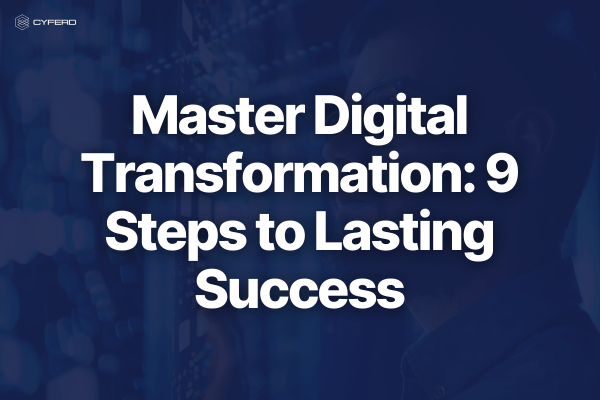Business

Master Digital Transformation: 9 Steps to Lasting Success
Introduction
Digital transformation is no longer optional; it’s a necessity for businesses that want to remain competitive and agile. According to McKinsey, up to 70% of digital transformation projects fail, often due to a lack of strategy, cultural resistance, or inadequate execution (McKinsey).
However, some organizations successfully navigate these challenges and achieve lasting success. The difference? A strategic, people-centered approach that prioritizes long-term outcomes over short-term wins. In this blog, we’ll uncover the secrets behind successful digital transformations and how your business can follow their lead.
Key Success Factors for Lasting Digital Transformation
1. Vision-Driven Strategy
A vision-driven strategy is the foundation of successful digital transformation. According to the Institute for Digital Transformation, setting clear and measurable goals at the outset ensures that digital initiatives align with business objectives (Institute for Digital Transformation).
How to Master It
– Define a clear vision with measurable outcomes linked to business goals.
– Involve cross-functional teams to ensure alignment and ownership.
– Continuously revisit and adapt the strategy as business needs evolve.
A McKinsey study found that companies that clearly communicate their digital strategy are three times more likely to succeed in their transformation efforts (McKinsey).
2. Culture of Continuous Learning
Digital transformation requires a shift in culture toward continuous learning and adaptation. Businesses that fail to invest in people and training often face resistance and stagnation. Gartner emphasizes that change management is crucial to overcoming cultural barriers (Gartner).
How to Master It
– Foster a culture of digital fluency and upskilling.
– Implement leadership-led adoption, where executives model digital practices.
– Regularly train and reskill employees to bridge competency gaps.
A GovNet article highlights how government agencies have embraced a culture of learning to drive transformation success (GovNet).
3. Agile and Phased Implementation
Transformation initiatives that attempt to overhaul everything at once often fail. Instead, agile and phased approaches enable iterative progress and rapid feedback loops (BTOES).
How to Master It
– Start with pilot projects and scale successful initiatives.
– Use agile methodologies to enable rapid adaptation.
– Continuously assess and pivot based on insights and outcomes.
4. Unified and Integrated Data Strategy
Data silos remain one of the biggest obstacles to transformation success. Research shows that data silos can cost employees up to 12 hours per week searching for information (VentureBeat).
How to Master It
– Implement AI-powered data harmonization to break down silos.
– Centralize data governance and enforce quality standards (Gartner).
– Ensure seamless data integration across all platforms and applications.

5. Flexible, Scalable Technology Stack
Relying on outdated or rigid systems hampers transformation. Selecting a scalable, cloud-based platform ensures adaptability and growth.
How to Master It
– Choose technology that integrates seamlessly with existing systems.
– Leverage cloud-based platforms to maintain flexibility.
– Use adaptive systems that evolve with your business needs.
6. Building a Digital-First Mindset
Fostering a digital-first mindset means viewing digital transformation as a continuous journey rather than a one-time project. This mindset empowers teams to embrace innovation and actively seek new ways to enhance processes and outcomes.
How to Master It
– Empower leadership to champion digital initiatives and model best practices.
– Encourage innovation at all levels by rewarding experimentation and idea generation.
– Cultivate a problem-solving culture where technology is viewed as an enabler rather than a barrier.
7. Data-Driven Decision Making
Data is at the core of successful digital transformation. Organizations that fail to leverage their data risk falling behind competitors who use data insights to inform strategy and operations.
How to Master It
– Invest in advanced analytics and AI tools to turn data into actionable insights.
– Train teams to interpret and leverage data effectively, ensuring data literacy throughout the organization.
– Use predictive analytics to anticipate customer needs and market trends.
8. Measuring Success: Metrics That Matter
Transformation without measurable results is a wasted effort. Establishing clear KPIs and regularly evaluating progress is essential to ensuring the transformation remains on track.
How to Master It
– Define success metrics aligned with business outcomes, such as customer satisfaction and revenue growth.
– Conduct regular performance reviews to assess progress and pivot where needed.
– Use data analytics to quantify the impact of digital initiatives.
9. The Cost of Inaction
Failing to transform digitally is a risk no business can afford to take. The cost of maintaining outdated systems and siloed data can significantly impact efficiency and competitiveness. In fact, organizations lose $12.9 million annually on average to data silo-induced inefficiencies (Gartner).
How to Master It
– Conduct a digital readiness assessment to identify gaps and risks.
– Prioritize investment in areas most at risk from a lack of innovation.
– Leverage flexible, AI-driven platforms to future-proof your business.

Why Cyferd Enables Mastery of Digital Transformation
Cyferd’s adaptive and scalable platform empowers businesses to overcome digital transformation challenges by unifying data, integrating seamlessly with existing systems, and leveraging AI-driven insights. By eliminating data silos and centralizing information, Cyferd reduces inefficiencies and enhances decision-making processes, enabling businesses to thrive in a dynamic digital landscape.
Data silos not only hinder efficiency but also carry a staggering financial cost. Breaking down these silos and creating a unified data strategy is essential to minimizing wasted resources and unlocking the full potential of data-driven insights. Cyferd addresses this challenge head-on by offering a single source of truth for your data, minimizing redundancy and promoting clarity across the organization.
Cyferd’s platform is designed to seamlessly integrate with existing technology stacks, reducing disruption during implementation while maximizing the value of previous investments. This flexibility ensures businesses can continue to innovate without being held back by legacy systems. Additionally, Cyferd’s AI-driven insights allow leaders to make data-backed decisions with confidence, transforming raw data into actionable intelligence.
Conclusion
Mastering digital transformation is not just about technology. It’s about creating a holistic approach that aligns strategy, culture, data, and technology to drive lasting success. By adopting a vision-driven strategy, fostering a culture of continuous learning, embracing agile implementation, breaking down data silos, and leveraging scalable technology, businesses can navigate the complexities of transformation with confidence.
Moreover, cultivating a digital-first mindset and making data-driven decisions are vital to maintaining momentum and relevance in an ever-changing landscape. Measuring success through meaningful metrics and understanding the cost of inaction further solidify the foundation for sustainable growth and innovation.
Digital transformation is a journey, not a destination. With the right approach, it becomes a powerful enabler of progress.
Ready to take the next step? Discover how Cyferd can help you master digital transformation and achieve your business objectives.
Find out more About Cyferd
New York
Americas Tower
1177 6th Avenue
5th Floor
New York
NY 10036
London
2nd Floor,
Berkeley Square House,
Berkeley Square,
London W1J 6BD
